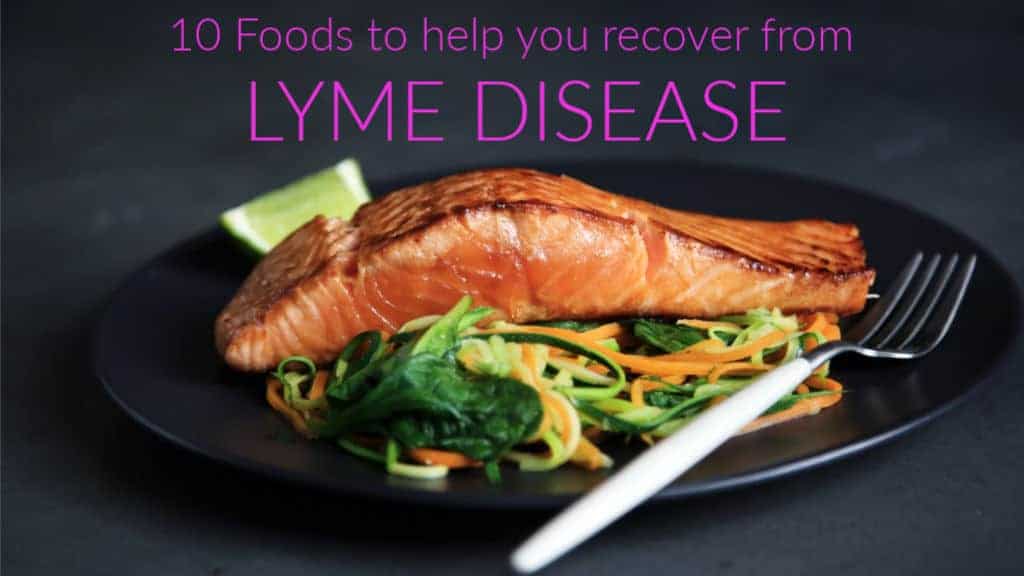Lyme disease treatment presents unique nutritional challenges. The disease triggers inflammation that spreads throughout your body. Fortunately, you can nourish your body with foods that help you improve your health and fight inflammation. Thus, you will help your body in its recovery from the ravages of this illness.
You need an anti-inflammatory diet
Lyme disease both causes problems with digestion and triggers inflammation. This event may cause you to lack appetite when you need essential vitamins and minerals the most!
So what’s the solution? Eating a diet of powerfully anti-inflammatory foods that also pack a nutritional punch. Let’s take a look at ten methods to give your body all that it needs as you recover from this illness,
Foods to Eat for Lyme Disease Prevention
Eating well is fundamental as your body repairs from the ravages caused by Lyme Disease. Proper nutrition is one of the wisest–and simplest–things you can do to improve your general wellness. However, it’s even more critical if you have Lyme disease.
Every person has their own taste in foods. So, find the meals on this list of anti-inflammatory foods that sound the tastiest to you, and be sure to consume them as you recover.
1 – Water
OK. You got us. Water is not a food. However, it tops our list in the numero uno spot, nevertheless!
Water comprises over 60 percent of the human body. Thus, it’s a priority every day to drink your fair share. Not only will it maintain your wellness, but it will also help fight any fever or infection that stems from your illness. Finally, it helps your liver flush toxins out of your system.
If you know you should drink more water, but you’re uncertain of the correct amount to drink, here are some water intake guidelines, according to science.
Adult Males:
The 2018 study cited above suggests that men drink 3700 milliliters, or 125 fluid ounces of water each day.
Adult Females:
In addition, the study recommends that adult females drink 2000 milliliters, approximately 68 fluid ounces daily.
Pregnant adult females should drink 2300 milliliters, 78 fluid ounces daily.
2 – Fatty Fish
Fatty fish, such as salmon, mackerel, and other cold-water species are well-documented sources of nutrients when you’re fighting inflammation. That powerful impact comes from the presence of Omega 3 fatty acids.
Omega 3s are so essential to the diet that science now recognizes it as Vitamin F.
Fatty fish serves a role as an essential source of protein as you recover from Lyme disease. And, if you get into a good habit of consuming oily fish regularly, you’ll gain an added benefit. That’s because these fish also improve arterial health, feed your brain the fats it needs, and fuels your metabolism.
3 – Sunflower Seeds
Do you think of sunflower seeds as a tasty snack food? They definitely are that, but they’re much more! Sunflower seeds deliver your body powerful punches of Vitamin E and help boost your body’s natural antibodies. That’s an essential job in the fight against inflammation.
Snack away at will on these healthy seeds. But, also consider adding them for a crunchy bite over your next salad or stir them into your oatmeal for added texture.
4 – Turmeric
Best known for its frequent use in Indian cuisine, Turmeric offers far more than tasty flavor to your curry dishes. Ancestral Indian healers used this ancient spice for centuries to cure everything from insect stings to arthritis pain to fevers–all inflammatory complications.
Because Lyme Disease often triggers inflammation and discomfort in the joints, it should be a go-to as you recover from Lyme disease. Besides, it helps to reduce the chances of complications like secondary bacterial infections you could contract while you’re improving.
5 – Leafy Greens
Because you probably feel sluggish and lethargic during recovery from this illness, you need to embrace leafy greens. Think spinach, collard greens, kale, mustard greens. etc.
These greens are high in nutrients to help you bounce back after this illness. Additionally, they improve anti-inflammatory benefits, improve your heart health, and boost your energy.
Remember that the darker green the vegetables, the more concentrated the nutrients.
6 – Kimchi
Kimchi, Korea’s famous fermented cabbage this is also critical food for fighting Lyme disease. That is because Kimchi aids your gut health.
This good bacteria is useful because it balances the “good bacteria” in your gut. That’s important in overcoming the impacts of Lyme disease. While most people don’t understand precisely what their gut does, many of the negative symptoms associated with Lyme link to gut health.
Poor gut health can trigger inflammation. So by prioritizing gut health and eating kimchi, you’ll be able to feel better–much sooner.
7 – Chickpeas
Whether you are eating a scrumptious hummus dip or tossing chickpeas into a salad, doing so will help to boost your general well-being after Lyme.
These delicious legumes are chock full of essential Vitamin B6. That vitamin is critical to helping support your immune system, which is stressed during a bout of Lyme.
It’s easy to sneak chickpeas into many dishes. That versatility makes it one of the simplest foods to consume while healing after Lyme.
8 – Sweet Potatoes
Whether you enjoy baked sweet potatoes or make a comforting soup, adding sweet potatoes, serve a vital role when you want to counteract the effects of Lyme.
That’s because sweet potatoes are high in Vitamin A. Thus, support a healthy immune system. And, the healthy dose of Vitamin A also helps you fight any secondary infections as you heal.
9 – Stevia
Stevia is a natural sweetener that might also be useful in combating Lyme as this sweetener can counter the impact of Borrelia burgdorferi bacteria, the species that infects your body with Lyme
A 2015 study suggests that Stevia is a biofilm disruptor that may destroy the biofilm produced by the aforementioned bacteria.
10 – Garlic Essential Oil
A 2018 study states that Garlic Oil is one of ten essential oils that help Lyme disease patients recover from their illness faster. While the study makes that statement, the research team also recommends further research is necessary to pinpoint more exact science.
But, the research makes garlic essential oil worth a try.
Foods to Avoid When Treating Lyme
So, now we’ve established that you must eat very well while treating this illness. On the flip side, it’s also critical that you avoid the foods that can trigger inflammation and thus worsen your condition. Here’s a list of ten such foods.
1 – Sugar
Terrible bugs such as Lyme and the candida yeast thrive on sugars. And that’s not even to mention that too much sugar intake might suppress your immune system.
Because sugar and sugary foods can wreak havoc on your body’s immune system, steer clear of sugar and sugary foods during your recovery period.
2 – Grains and Gluten
You should also take care to avoid grains or products with gluten as you recover from this illness. Even if you are not allergic to gluten, it’s essential to eliminate these from your nutrition plan at this time.
Anecdotal evidence reveals that Lyme patients report feeling better, overall after they cut out grains and gluten from their diet. Additionally, experts link grains to issues with cognitive function and also a leaky gut.
3 – Dairy
If you can tolerate dairy during your recovery, be sure to consume only organic products. However, if you usually are even slightly sensitive to dairy products, then avoid it altogether during your recovery.
Dairy products cause inflammation in those who are sensitive, adding to the feeling of unwellness.
4 – GMOs
High in pesticides and generally unhealthy, Genetically Modified Organisms (GMOs) connect to inflammation and cause poor gut health. Therefore, Lyme disease patients must avoid them at all costs. Some commonly-consumed GMO foods include the following: corn, soybeans, milk, and canola.
5 – Caffeine and Alcohol
As we mentioned in food to eat #1, water, proper hydration is fundamental in fighting this ailment.
Conversely, caffeine, and alcohol, which lead to dehydration, can create severe problems for you if you suffer from this illness.
6 – Trans Fats
You may already avoid trans fats as they have so many negative consequences for heart health. If you don’t, then know that they trigger inflammation and cause a sluggish immune system and metabolism. Thus, avoid them for Lyme’s recovery.
7 – Foods with Dyes, Colors, and Additives
Foods that contain synthetic or additives, cush as preservatives, dyes, or colorings trigger a myriad of health concerns. These human-made consumables are inferior for your overall well-being.
Final Thoughts on Lyme Disease Prevention
For those contending with this illness, an intentional, healthy eating plan is the first step in recovering from feelings of ill health you’re currently experiencing. While eating well, alone, will not cure your disease, you will support your recovery by making smart food choices.


















